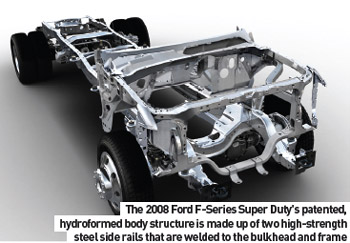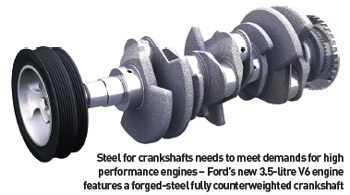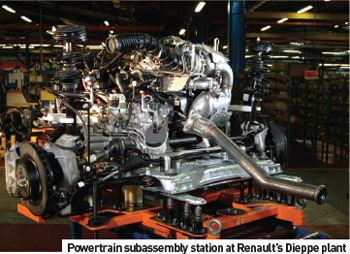The high performance demands of powertrain mean the steel used must be strong and machined with precision. AMS looks at the latest innovations at Corus
The demands on modern manufacturing technologies, such as dry machining, fracture splitting and the elimination of excessive heat treatment place a diverse range of challenges on manufacturers of powertain steel materials.
Different elements of the powertrain demand different properties: connecting rods demand high strength in tension and compression, crankshafts must cope with high loads, while CV joints have to cope with the heavy loads in delivering power. Companies such as Corus, Uddeholm and Arcelor are continually developing products to meet the needs of automotive OEMs.
The steels required for the manufacturing of connecting rods need to meet the demands of high performance engines, lightweight design, component reliability and low through-cost manufacturing.
The rod and cap are usually produced as a single unit and subsequently separated, although fracture splitting of the rod and cap is a major industry development and gives significant cost saving compared with conventional machining. The traditional method of manufacturing connecting rods involves machining the crankshaft and pin bore holes in the connecting rod, and then separating the rod and cap to facilitate installation on the crankshaft. This is a difficult operation requiring extremely high-precision in machining the mating surfaces of the rod and cap.
The fracturing process pioneered by MAG Powertrain eliminates the complex machining required to achieve precision mating of the cap and rod. Instead, the cap is separated from the rod at a precisely predetermined position by fracturing. The separated faces remain unmachined, their rough surface finish ensuring perfect mating during subsequent connecting rod assembly. The degree of mating accuracy far exceeds that achieved using conventional techniques.
 As for the material itself, because connecting rods operate under high loads, they require high strength in both tension and compression, as well as high fatigue strength. The highly efficient engines of modern automobiles demand the lowest possible component weight, and that includes the connection rods. Therefore the trend for slender rod designs must have materials with good rigidity, as well as high strength and weight consistency to facilitate engine balancing.
As for the material itself, because connecting rods operate under high loads, they require high strength in both tension and compression, as well as high fatigue strength. The highly efficient engines of modern automobiles demand the lowest possible component weight, and that includes the connection rods. Therefore the trend for slender rod designs must have materials with good rigidity, as well as high strength and weight consistency to facilitate engine balancing.
Forged steel offers the best combination of strength, stiffness and cost. Cast iron rods are heavier and sintered powder products are more expensive. In future, the rod and cap will be fracture split to minimise cost for most volume produced connecting rods.
Aside from the fracturing process, the most evident manufacturing concern is the ever present demands for lower cost, including the calls for the elimination of a heat treatment process, the improved machinability for high volume production and low distortion on fracture splitting
High proof and fatigue strength steels are desirable. Steels are being developed that retain the fracture splitting characteristics and machinability of existing grades.
Controlled air-cooled steels have largely replaced heattreated steels for connecting rod applications. Higher strength grades are required for the heavier loads typically found in diesel engines and higher performance petrol driven cars. Weight reduction and packaging constraints are also driving up the need for higher strength materials.
Steel for crankshafts needs to meet demands for high performance engines, which means lightweight design, component reliability and low through-cost manufacturing.
In converting the linear motion of the piston into rotational motion, crankshafts operate under high loads and require high strength. Elimination of the conventional heat treatment process by utilising air-cooled steels offers manufacturers significant cost savings.
Crankshafts require high strength and stiffness to withstand the high loads in modern engines, and to offer opportunities for downsizing and weight reduction. They must also be resistant to fatigue in torsion and bending and wear in the bearing areas.
The manufacturing route for forged steel crankshafts is usually hot forging, heat treatment, machining and surface treatment. Controlled air cooling after forging is lower cost than the traditional quench and temper and is now the preferred route.
Steels for driveline systems must withstand heavy loads in delivering power to the steered wheels of modern vehicles. CV joints and driveshafts are made and finished to high standards for reliable and efficient operation.
The torsional loading and rotational motion in the system determine the main requirements for CV joints and driveshafts – these being high strength with a tough core, hard wear resistant surface and resistance to failure by torsional and rolling contact fatigue.
The outer races are precision formed, usually by warm forging from bar, followed by machining and induction hardening. Inner races and tripods are cold forged, machined and carburise heat-treated. Drive shafts are produced from peeled bar and the splines are formed by cold rolling. The entire surface is then induction hardened.
An efficient manufacturing process for each of these components demands sufficient ductility for the forming process, good machinability and consistent and repeatable response to heat treatment.
Outer races and driveshafts are made from medium carbon through hardening steels while inner races and tripods are made from low-carbon carburising steels. Lean manufacturing throughout the supply chain offers the most scope for further improved value CV joints and driveshafts. Existing steel enhancements fully satisfy anticipated future performance requirements.
Common rail and integral unit injector systems accurately deliver fuel at high pressure for efficient combustion, better fuel economy and lower emissions. High strength steels for nozzles, body holders and unit injectors are produced to exceptional levels of cleanliness for maximum fatigue resistance.
Nozzles must have high mechanical strength to tolerate the high system pressures as well as resistance to the fatigue stresses imposed by the fuel delivery cycle and durability at high combustion temperatures. Nozzle body holders are also subjected to high fatigue stresses from pulsating fuel pressures. Additionally, weight and packaging constraints are demanding smaller components. Nozzle body holders and unit injector bodies therefore need high mechanical strength to resist the ever increasing fuel pressures and fatigue resistance, especially in regions of high stress.
Nozzle production is a high volume operation which demands good machinability and appropriate heat treatment response to give the final properties. Nozzle body holders and unit injector bodies can be machined from bright bar, or hot forged then machined. A heat treatment process follows machining. Optimal processing of these components requires good machinability with special reference to gun drilling of small holes and minimum distortion on heat treatment.
For nozzles, a low carbon case hardenable steel has been developed that fulfils the essential requirements for excellent machinability in the pre-heat treated, annealed condition, as well as high strength and fatigue resistance after heat treatment and strength at elevated temperatures.
Nozzle body holder and unit injector bodies have more demanding machinability requirements. For these applications there are bars with exceptional straightness which are stress and defect free to avoid hole drift during gun drilling, while controlled resulphurised or leaded steels further improve machinability.Diesel demands Diesel injection engineering is developing rapidly in response to the increasing demands from automotive OEMs. Like other steelmakers Corus works closely with manufacturers to develop steels that meet the needs for higher operating pressures, temperatures and reliability.
A case in point is the successful range of new, extremely clean steels that will help manufacturers of the latest generation of diesel fuel injection systems meet the growing demand from carmakers for improvements in performance, fuel efficiency and cost.
Diesel passenger car sales have risen steadily across Europe over the last ten years thanks to consumer demands for better fuel economy and growing pressure on vehicle manufacturers to reduce CO2 emissions. Coupled with the growth in diesel car sales has been the demand from motorists for improvements in performance, driving characteristics and refinement, resulting in vehicle manufacturers turning increasingly towards new diesel engine technology to help them meet the engineering challenges.
The introduction of common rail fuel injection systems, which work at higher pressures to improve atomisation of fuel for more power output and better engine performance, is one example of the latest advances. However, the use of new technology to make diesel engines more efficient is placing even greater challenges on the materials specified for critical components such as injectors.
Injector bodies and nozzles are required to work at high injection pressures and are therefore subject to high fatigue loading as well as being required to respond well to higher heat tolerances. In addition to these demanding requirements, the components are also produced in large volumes and therefore must be easily machined.
To help improve the durability and performance of injector components, Corus has worked closely with diesel injection system manufacturers to develop a range of new, extremely clean steels with far fewer non-metallic inclusions. In addition, system manufacturers have benefited from Corus's extensive and proven track record in market sectors such as bearings and aerospace, which also require high quality high performance steel products.
 Key benefits of the clean steels for diesel injectors include a consistent heat treatment response and excellent machinability. These features are paramount to meet the demands of the high injection pressures present in the close tolerance gun-drilled holes of the fuel delivery system.
Key benefits of the clean steels for diesel injectors include a consistent heat treatment response and excellent machinability. These features are paramount to meet the demands of the high injection pressures present in the close tolerance gun-drilled holes of the fuel delivery system.
In the case of steels for injector nozzles, Corus products exhibit extremely high cleanness, consistent hardenability and increased fatigue resistance, which importantly, help improve the life expectancy of diesel injector components.
In addition, all of these attributes are required to enable fuel to be delivered to the ignition chamber at high cyclical pressures through laser-drilled spray holes, often as small as 0.1mm in diameter.
Commenting on the development of these new steels, Martin Read, Senior Metallurgist, Corus Engineering Steels says: “By working closely with us, the diesel injection system manufacturers have not just benefited from our proven material technology but also our well-established and world-class clean steel manufacturing processes that ensures the production of a consistently high quality material.”
Corus clean steel manufacturing practice involves careful control of steelmaking to casting, from raw material to product, via well defined procedures established over many years by Corus’ experts in market sectors such as bearings and aerospace, with particular attention being given to oxygen content. Corus’s automotive customers, including injection system manufacturers, are now benefiting from this practice.
Read adds: “Corus is continuing to work closely with diesel injection manufacturers to help provide material solutions to the new challenges ahead. These include tougher future environmental legislation which will require diesel engines to be even more efficient, and the need to reduce vehicle component weight placing even greater demand on materials used within the engine system.”
Gearbox steels need to withstand the high stresses at the mating surfaces and in the core of gears transmitting rotational forces from the engine and crankshaft to the road wheels.
 Consistency of material response during manufacture, particularly on final heat treatment, minimises expensive rectification and reduces gearbox noise and vibration.
Consistency of material response during manufacture, particularly on final heat treatment, minimises expensive rectification and reduces gearbox noise and vibration.
Transmission gears require hard wear resistant surfaces, resistance to tooth root bending fatigue and surface fatigue.
It also requires dimensional accuracy for smooth meshing and reduced noise, vibration and harshness (NVH).
Transmission gears have a complex manufacturing route usually involving forging, machining, heat treatment and surface improvement treatment. The continuous pressure on component manufacturers for low through costs demand a predictable distortion effect of heat treatment to eliminate or reduce hard machining operations.
The majority of transmission gears are case hardened by carburising to achieve a high surface hardness and a tough core.
Corus has developed a range of lean alloy steels that will enable the automotive gearbox industry to control and predict the level of distortion in the manufacture of transmissions. This will help the industry produce gearboxes and shafts with improved NVH characteristics, and importantly, help both to reduce costs through improved machine-ability and allow for more environmentally-friendly production processes.
The automotive gearbox industry today faces the challenge of manufacturing transmissions that not only meet growing consumer demands for improved refinement and performance, but also meet more stringent legislation affecting production and service.
Distortion of material in the manufacture of gearboxes is usually caused by heat treatment after machining. This is inevitable and is a major contributor to increased NVH, together with a reduction in performance. However, given the ability to predict the levels of distortion, manufacturers now can allow for its effect and design their processes accordingly.
Utilising its extensive material knowledge and experience of working with the gearbox industry, the company has developed a range of new low alloy gear steels that gives manufacturers this ability to control distortion and limit its impact.
Corus’ low alloy gear steels feature chemical compositions tailored to produce a tightly controlled and repeatable hardenability response, a critical property for ensuring that fatigue and performance requirements in transmissions are met. Importantly, these leaner alloy steels display comparable hardenability to the more highly alloyed steels previously available.


































